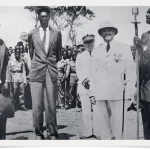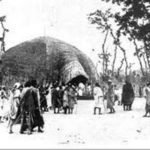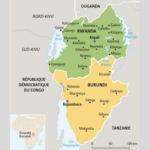The Rwandan Context of the Royal Rituals
Following a period of important military expansion and internal political consolidation, the kingdom of Rwanda included close to two million people within a highly centralized polity and hierarchized society at the time of European arrival in the early twentieth century. Accompanying the institutional developments in the social and political domains of Rwandan culture over the previous century was a remarkable elaboration of court culture in general, including royal ritual forms of considerable complexity. The central focus of the latter was the esoteric ritual Code, the Ubwiiru, composed of eighteen separate but interrelated rituals. Seventeen of these (amounting to some 4,766 lines) are included in a most extraordinary publication, La royauté sacrée de l’ancien Rwanda, edited by Marcel d’Hertefelt and André Coupez, on which the present analysis is based.
The specific ritual considered here is the annual First Fruits ceremony (Ritual VIII in the Code: Inzira y’Umuganura). Though culminating at the time of the sorghum harvest (February–March), the full ritual was composed of four temporal segments spaced throughout the year: at the appearance of the moons of kaanama (August–September), uzeri [nzeli](September–October), mutarema [mutarama] (January– February), and gashantare (February–March).This umuganura ceremony was selected for analysis here for three reasons. It was one of the major social and ritual events of the kingdom, an annual festivity culminating (normatively) at a time of plenty and rejoicing, and it touches on very broad questions pertaining to the nature of society in general and the role of kingship within it. Furthermore, it is also a type of ritual widespread among neighboring peoples; the umuganura ritual of Rwanda includes prominent features shared among several kingdoms within the region, thus opening the possibility of ethnographic (if not also structural) comparisons. Finally, though complex—and this presentation omits or only barely touches on the complexity and significance of color symbolism, social interactions, the items used and their materials of fabrication (sometimes rigorously prescribed), the relations of ritual to other art forms (especially myth), and other similar aspects—the umuganura text is still of manageable length for these purposes. (It is 386 lines long; the enthronization ritual, by contrast, includes 1,249 lines, and that itself is neither the longest nor the most complex of the seventeen rituals included in the published Code.)
The most important methodological point to make here is that umuganura comprised only part of the integrated Code of royal ritual. There are many indications within the Code itself—including aspects of one ritual repeated in another —that establish that the separate rituals are conceived of as an integral whole; each one, then, is only part of the ritual physiology of the living kingdom. In extracting only one ritual for analysis here, I have consequently done violence to the integrity of the whole as well as to the subtlety and savor of the part. But the attempt to explore these aspects more fully would have exceeded the resources available to me and placed unfair demands on the patience of the reader. Within the limitations of time and space, however, I have tried to be fair to the concept of the Code as a whole.
https://uk.amateka.net/the-rwandan-context-of-the-royal-rituals/https://uk.amateka.net/wp-content/uploads/2021/03/smbpp.pnghttps://uk.amateka.net/wp-content/uploads/2021/03/smbpp-150x150.pngSocial & cultureFollowing a period of important military expansion and internal political consolidation, the kingdom of Rwanda included close to two million people within a highly centralized polity and hierarchized society at the time of European arrival in the early twentieth century. Accompanying the institutional developments in the social and political...BarataBarata rpierre@ikaze.netAdministratorAMATEKA | HISTORY OF RWANDA



